Using
the "F" Word – The Role of Fitness in Historical Fencing
The exercise of the body goes
hand in hand with the Exercise of Armes.
Renaissance
martial arts were a highly athletic activity. Yet, to be honest, the
role of fitness in historical fencing is a delicate issue for some
students. The subject is admittedly a sensitive one for many sincere
practitioners burdened by modern sedentary lives or other non-physical
careers behind desks. No one likes being reminded that they are out of
shape or in poor physical condition either. And to be honest, among the
historical-reenactment community this problem is frequently endemic and
at present, in America, obesity itself is epidemic. So, any discussion
of the necessity for physical fitness in the earnest performance of
Renaissance martial arts is sure to cause discomfort among some readers
and even resentment among others. For
far too many enthusiasts of historical fencing, fitness is a “four
letter word” that inconveniences their fantasy view of Medieval and
Renaissance close-combat.
In the study of
what are at heart vigorous physical activities it is perhaps human
nature, rather than to feel inspired or motivated, to tend instead to
be agitated or irritated by reminders of the import of athleticism.
This is especially true today with a subject frequently pursued as
casual diversion and mere escapism. That fitness should be at all
anathema in a craft that is first and foremost a physical activity is
perplexing. But this article will attempt only to address the
role, historical and practical, of physical conditioning in the
practice of Renaissance fighting skills.
The Traditional Position
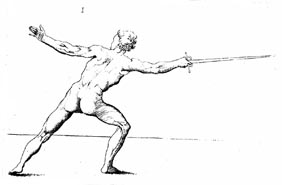 As with many things, Italy was
the origin and fount of ideas on physical fitness during the Renaissance.
Following from both a classical Greco-Roman model and the value
placed on physical feats within chivalric literature, military
men recognized its significance for health and activity.
Repeated advice can be found in 14th and 15th
century literature concerning the physical fitness value of swimming,
running, climbing, jumping, vaulting, fencing, and wrestling.
The Renaissance humanist educators also expressed the idea of
virtus as a form of moral excellence; the virtue of achieving
one's potential, of which physical prowess and fitness was a part.
As Dr. Sydney Anglo wrote in his 1997 article on Tudor spectacles,
"physical strength and skill in martial exercise were only part
of the manifold talent expected of the ideal Renaissance prince."
As with many things, Italy was
the origin and fount of ideas on physical fitness during the Renaissance.
Following from both a classical Greco-Roman model and the value
placed on physical feats within chivalric literature, military
men recognized its significance for health and activity.
Repeated advice can be found in 14th and 15th
century literature concerning the physical fitness value of swimming,
running, climbing, jumping, vaulting, fencing, and wrestling.
The Renaissance humanist educators also expressed the idea of
virtus as a form of moral excellence; the virtue of achieving
one's potential, of which physical prowess and fitness was a part.
As Dr. Sydney Anglo wrote in his 1997 article on Tudor spectacles,
"physical strength and skill in martial exercise were only part
of the manifold talent expected of the ideal Renaissance prince."
In the early
1400s the educator Vittorino da Feltre, "required as a correlative to a
fine intellectual humanism a standard of physical excellence and
personal bearing to match." To Vittorino, "The purport of such training
was to develop an easy, graceful bearing, suppleness, and dignity of
figure." As such, he stressed for youth the importance attached to
diet, clothing, and exercises as well as being inured to cold and
prolonged exertion. The educator and expert in arms Leon Battista
Alberti in the mid-1400s advocated and practiced martial arts, "for the
sake of health rather than sport or pleasure." Also in the mid
1440s, Aneneas Sylvius Piccolomini (who later became Pope Pius II)
argued that active training in physical exercises helped to create
total fitness as well as a physically pleasing body, both of which
helped the individual bear arms in a manly fashion.
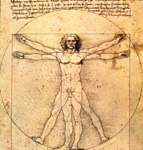 We see this same view toward bodily strength in the 16th
century. For example, the famed Castiglione much later wrote that
the ideal courtier had to possess, "strength, lightnesse, and
quicknesse," as well as "an understanding in all exercises of
the bodie that belong to a man of warre." One historian
wrote of English gentlemen in the 16th century,
"The renaissance ideal of education combined training
of the mind with training of the body; as it was applied to the
mere scholar, therefore, it taught him to care for his body, which
had been sadly neglected in [early] medieval theory." Interestingly though, in the late 14th
century the French poet Eustace Deschamps compared knights of
his time unfavorably with those of the past, writing how men of
his day were soft and not interested as much in training or exercising
as were earlier generations, even calling instructors of the time
cowards. By the 15th century however, the Renaissance
ideal soon overshadowed the Medieval mindset.
We see this same view toward bodily strength in the 16th
century. For example, the famed Castiglione much later wrote that
the ideal courtier had to possess, "strength, lightnesse, and
quicknesse," as well as "an understanding in all exercises of
the bodie that belong to a man of warre." One historian
wrote of English gentlemen in the 16th century,
"The renaissance ideal of education combined training
of the mind with training of the body; as it was applied to the
mere scholar, therefore, it taught him to care for his body, which
had been sadly neglected in [early] medieval theory." Interestingly though, in the late 14th
century the French poet Eustace Deschamps compared knights of
his time unfavorably with those of the past, writing how men of
his day were soft and not interested as much in training or exercising
as were earlier generations, even calling instructors of the time
cowards. By the 15th century however, the Renaissance
ideal soon overshadowed the Medieval mindset.
Yet, a knight's training clearly
emphasized physical conditioning and self-discipline as well as martial
skills. During the Age of Chivalry physical education was revived as a
complex military education and strenuous training was required of
knights and men at arms. Ancient Germanic and Celtic customs of
initiation into manhood and military service also played a part in the
later rituals of knighthood. Training produced not just physical
skill but discipline. The historian of physical education Earle
Ziegler noted that the aim of physical education during the feudal and
manorial period served a practical objective of producing a man
possessing all the necessary physical and psychological attributes for
skill in hand-to-hand combat arts.
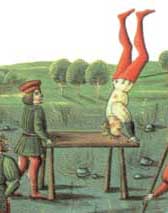 One description of knightly
martial training comes to us from a 14th century ballad on knighthood
by Deschamps who wrote how knights had gained hardiness through
long apprenticeship and training, ridden long journeys, practiced
wrestling and throwing the stone, scaling forts, and combating
with shield and sword. Offering a 14th century view of "ancient"
training, Deschamps' expressed that following from custom they
"In times of peace" would not doubt "To practice acts of chivalry"
in "Jousts, tournaments, wrestling, and throwing rocks [and] fencing."
One description of knightly
martial training comes to us from a 14th century ballad on knighthood
by Deschamps who wrote how knights had gained hardiness through
long apprenticeship and training, ridden long journeys, practiced
wrestling and throwing the stone, scaling forts, and combating
with shield and sword. Offering a 14th century view of "ancient"
training, Deschamps' expressed that following from custom they
"In times of peace" would not doubt "To practice acts of chivalry"
in "Jousts, tournaments, wrestling, and throwing rocks [and] fencing."
The historian E. Prestage once described
how in 14th century France, the armiger, or young
squire, whose training in the mesnée was the subject of
numerous reflections in the Chansons de Geste, "grew up in the
martial traditions of an athletic community, that valued prowess above
all things. He was taught the management of horses, the care and use of
arms, fencing (which developed the lungs and made one "fitter and more
erect and much straighter for it")..." Prestage also noted the squire
"had to undergo a strenuous course of exercises calculated to increase
his strength and dexterity." The necessity for accurate control over
the movements of a horse in battle also led to special exercises known
as voltige, consisting of jumping into and out of a saddle or
onto a table. Later actual wooden horses were used to practice
this. By the 11th century vaulting in this way became an art in itself
and continued well into the 18th century where it became the
source of today's gymnastic pommel horse.
Another example of the physical training a
young esquire seeking knighthood would undergo in the late 1300s comes
to us from Jean Le Meingre (Boucicaut), the marshal of France during
the reign of Charles VI, who founded the order of the Dame blanche
a licu vert, a society that defended the wives and daughters of
absent knights. Boucicaut described a regimen heavy on exercise
fitness: "Now cased in armour, he would practise leaping on to the back
of a horse; anon, to accustom himself to become long-winded and
enduring, he would walk and run long distances on foot, or he would
practise striking numerous and forcible blows with a battle-axe or
mallet. In order to accustom himself to the weight of his armour, he
would turn somersaults whilst clad in a complete suit of mail, with the
exception of his helmet, or would dance vigorously in a shirt of steel;
he would place one hand on the saddle-bow of a tall charger, and the
other on his neck, and vault over him…He would climb up between two
perpendicular walls that stood four or five feet asunder by the mere
pressure of his arms and legs, and would thus reach the top, even if it
were as high as a tower, without resting either in the ascent or
descent…When he was at home, he would practise with the other young
esquires at lance-throwing and other warlike exercises, and this
continually." (Lacroix, p. 146). This thought is echoed in that of Dom
Duarte, king of Portugal, more than a century later when in his 1434
work on fencing, the Regimento, which following from Vegetius's advice
for training Roman soldiers, he advised that a wooden horse be kept to
practice jumping on and off the saddle as well as being accustomed to
sitting mounted in armor. (Anglo, Martial Arts, p. 257). Interestingly,
Dom Duarte discerned differences in physical results of sports compared
to martial arts when he warned, if a knight wanted a good arm for
fencing, he should avoid playing ball games-especially any requiring
the throwing of either light or heavy objects as this could weaken
military skills. (Anglo, Martial Arts, p. 257).
Boucicaut's exercises, which he devised to make
himself more effective in battle, included running long distances to
build up his stamina and to build up his arm muscles and toughen his
hands spent long periods striking with his fists or with a hammer. (H.
Nicholson, p. 116-117). Literature of the period, while referring
frequently to tournament and joust as military training for knights,
makes few references to common fencing masters giving practical
instruction in weapon handling to the nobility. It has been
therefore suggested that because Boucicaut placed such stress on these
martial exercises they were somehow unusual. This might possibly have
been so among the majority of nobles and military commanders but surely
not men-at-arms of the warrior class. Is it any surprise then that in
his 1542 martial arts compendia, Paulus Hector Mair, a collector or Fechtbuchs
as well as a practitioner of the craft, referred to the subject by the
Latin, artes athleticae? Mair even entitled his work the
"Ultimate Book of Athletics."
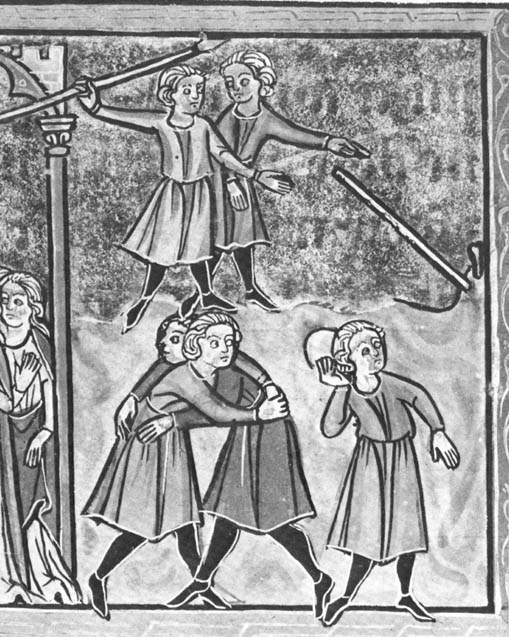 While the
ordinary man was engaged in exhausting farming and trades with less
time for military expertise, evidence shows that the primary training
of the feudal classes consisted of riding, jousting, wrestling,
strength training by lifting large stones, and later calisthenics and
even gymnastics. A chronicle from the year 1075, the Annales
Lamberti, complained of a lack of physical fitness among laboring
peasants which discouraged nobles from pressing them into military
service as foot soldiers. In contrast, the warrior class accepted that
their leisure time often made them soft while their role in society
demanded peak physical performance. One Victorian historian
observed at the turn of the century, "The first professional fighters
were the aristocracy, who spent their time almost entirely in the daily
practice of arms, and kept themselves in perfect training by constant
exercise…And this superiority they gradually supplemented by means of
armour…" In 1283, King Alfonso X of Castile commissioned a treatise on
games and recreations which described various kinds of pastimes "in
which men use their limbs and therefore relax and take joy" including
those practiced on foot such as fencing and wrestling as well as
throwing stones or darts. It begins with words that infer that God
wished men to have every kind of joy for its own sake so that they
might therefore be better able to bear cares and labors. In 1315, a
physician in Valencia advised indoor exercises for staying healthy
which included climbing stairs rapidly three or four times and then
wielding in either hand a large heavy stick like a sword as if in
fighting until you are almost winded.
While the
ordinary man was engaged in exhausting farming and trades with less
time for military expertise, evidence shows that the primary training
of the feudal classes consisted of riding, jousting, wrestling,
strength training by lifting large stones, and later calisthenics and
even gymnastics. A chronicle from the year 1075, the Annales
Lamberti, complained of a lack of physical fitness among laboring
peasants which discouraged nobles from pressing them into military
service as foot soldiers. In contrast, the warrior class accepted that
their leisure time often made them soft while their role in society
demanded peak physical performance. One Victorian historian
observed at the turn of the century, "The first professional fighters
were the aristocracy, who spent their time almost entirely in the daily
practice of arms, and kept themselves in perfect training by constant
exercise…And this superiority they gradually supplemented by means of
armour…" In 1283, King Alfonso X of Castile commissioned a treatise on
games and recreations which described various kinds of pastimes "in
which men use their limbs and therefore relax and take joy" including
those practiced on foot such as fencing and wrestling as well as
throwing stones or darts. It begins with words that infer that God
wished men to have every kind of joy for its own sake so that they
might therefore be better able to bear cares and labors. In 1315, a
physician in Valencia advised indoor exercises for staying healthy
which included climbing stairs rapidly three or four times and then
wielding in either hand a large heavy stick like a sword as if in
fighting until you are almost winded.
Aegidius
Romanus in the early 14th century wrote that a military
leader needed to be attentive to exercitatio, or individual
drill, noting that, "having arms unaccustomed to striking and limbs
untrained for fighting" was useless for soldiers. He also
stressed the importance of practice as toughening to endure hardship as
well as "hardness of body". Medieval texts also describe young knights
training with weapons of double weight in order to develop
strength. Here we might recall the instructions of the Roman
military writer Vegetius's (widely read in the age) describing the
traditional training of soldiers. Vegetius told how young legionnaire
recruits were given double-weight swords and shields to train hard by
striking at posts. In this way, when the recruit took up real and
lighter weapons, "as if freed from the heavier weight, he will fight in
greater safety and speed."
 Petrus
Vergerius in the early 1400s similarly wrote how in war skills alone
were useless without the strength and endurance needed to bear the
rigors of campaigning. Equally, Alberti Battista in the mid 1400s
advocated: "In all training no end may be preferred to that of physical
soundness" saying "Games which require dexterity, endurance, strength,
qualities of eye and nerve, such as fencing…" were to be
preferred. A number of other 15th century humanist
writers on physical education also repeatedly stressed the importance
of muscular strength and conditioning. We might recall the
various images of weight-training in Medieval artwork showing heavy
stone lifting or throwing by fencers (similar perhaps to the modern
"medicine ball" exercise tool) as well as the use of heavy sticks
equivalent to later "Indian club" exercise tools.
Petrus
Vergerius in the early 1400s similarly wrote how in war skills alone
were useless without the strength and endurance needed to bear the
rigors of campaigning. Equally, Alberti Battista in the mid 1400s
advocated: "In all training no end may be preferred to that of physical
soundness" saying "Games which require dexterity, endurance, strength,
qualities of eye and nerve, such as fencing…" were to be
preferred. A number of other 15th century humanist
writers on physical education also repeatedly stressed the importance
of muscular strength and conditioning. We might recall the
various images of weight-training in Medieval artwork showing heavy
stone lifting or throwing by fencers (similar perhaps to the modern
"medicine ball" exercise tool) as well as the use of heavy sticks
equivalent to later "Indian club" exercise tools.
The famed 14th century knight, Geoffrey De
Charny, in his treatise on chivalry criticized even entitled some of
his chapters, “A Good Man at Arms Should Not Pamper His Body” and “A
Good Man at Arms Should Not Fear Discomfort.” At one point Charny
specifically criticized overweight knights writing of those who tried
to fit themselves into armor but could not perform well: “one has seen
many of those thus constricted who have to take off their armor in a
great hurry, for they could no longer bear to wear their equipment; and
there are others who have been quickly seized, for they could not do
what they should have done because they were handicapped by being thus
constricted; and many have died inside their armor for the same reason,
that they could put up little defense. And even without their
armor they are so constricted and strapped up that they cannot
undertake anything, for they cannot bend down, nor can they run nor
jump nor threw stones nor engage in any other sports requiring strength
or agility; indeed they can hardly sit down, and it demands just as
great an effort to struggle to their feet again. There might be
some who would prefer to give the appearance of being a good man at
arms rather than the reality, but no one, however devious or simple,
would doubt that when it comes to achieving something, whether in or
out of armor, it is those who perform the greatest deeds whose name are
on everyone’s lips and who are most honored.” (De Charny, Chapter 42).
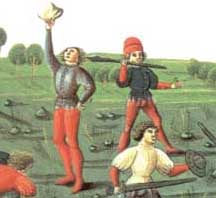 Curiously,
despite the famous bulky size of 16th century armors
such as those of Henry VIII, writing of the gentlemen in 16th
century France, one historian of the Renaissance noted: "Even
when he was in the best of health and in full armor, the gentleman
of the Renaissance was not a very large man. The ideal of the
Renaissance, descended from antiquity through the Italians, was
that it was preferable for a man to be moderate in size. Men that
were too big were likely to be clumsy and lacking in grace. On
the other hand, a man should not be so small as to be unimpressive.
For a gentleman to be completely acceptable as to physique, he
should strike a golden mean of size…A gentleman's prime
claim to handsomeness is in the harmony and balance of his figure.
If he does not have this, perfection of individual details like
the eyes, teeth, nose, or lack of bodily odors will not make him
attractive." Within Western culture this corresponded to
the Greek ideal of the optimal man proportioned with broad shoulders
and a narrow waist accompanied by long and strong limbs--the natural
athlete.
Curiously,
despite the famous bulky size of 16th century armors
such as those of Henry VIII, writing of the gentlemen in 16th
century France, one historian of the Renaissance noted: "Even
when he was in the best of health and in full armor, the gentleman
of the Renaissance was not a very large man. The ideal of the
Renaissance, descended from antiquity through the Italians, was
that it was preferable for a man to be moderate in size. Men that
were too big were likely to be clumsy and lacking in grace. On
the other hand, a man should not be so small as to be unimpressive.
For a gentleman to be completely acceptable as to physique, he
should strike a golden mean of size…A gentleman's prime
claim to handsomeness is in the harmony and balance of his figure.
If he does not have this, perfection of individual details like
the eyes, teeth, nose, or lack of bodily odors will not make him
attractive." Within Western culture this corresponded to
the Greek ideal of the optimal man proportioned with broad shoulders
and a narrow waist accompanied by long and strong limbs--the natural
athlete.
An example from Jean Le Meingre in the
late 1300s of the training a young esquire seeking knighthood would
undergo describes a range of physically demanding exercises: "Now cased
in armour, he would practise leaping on to the back of a horse; anon,
to accustom himself to become long-winded and enduring, he would walk
and run long distances on foot…In order to accustom himself to the
weight of his armour, he would turn somersaults whilst clad in a
complete suit of mail, with the exception of his helmet, or would dance
vigorously in a shirt of steel; he would place one hand on the
saddle-bow of a tall charger, and the other on his neck, and vault over
him…He would climb up between two perpendicular walls that stood four
or five feet asunder by the mere pressure of his arms and legs, and
would thus reach the top, even if it were as high as a tower, without
resting either in the ascent or descent..."
 The noticeable
activity of lifting or throwing heavy stones as exercise or sport
is encountered repeatedly among all classes. In a text on the
pastimes of Londoners from c. 1178 we read how, "In the holidays,
all the summer the youths are exercised in leaping, dancing, shooting,
wrestling, casting the stone" [shot-put]. An English text
from the year 1184 noted some knights "contended…in throwing
heavy stones".
The noticeable
activity of lifting or throwing heavy stones as exercise or sport
is encountered repeatedly among all classes. In a text on the
pastimes of Londoners from c. 1178 we read how, "In the holidays,
all the summer the youths are exercised in leaping, dancing, shooting,
wrestling, casting the stone" [shot-put]. An English text
from the year 1184 noted some knights "contended…in throwing
heavy stones".
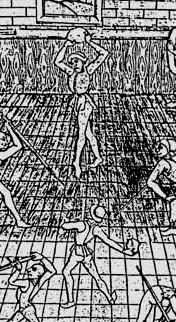 In Havelok the Dane, written
between 1280 and 1290, we read of this in a description of knights
enjoying exercise: "The moste joye that mouhte be—Wrastling
with laddes, putting of ston" (i.e, threw heavy stones). In
a short English play from c.1470, "Robyn Hod and the Shryff off
Notyngham," several activities are described similar to those traditionally
performed in May games, including stone throwing, wrestling, and
vigorous sword fighting. Illustrations of German fencers from
the 15th century depict them engaged in a range of activities
from wrestling and lifting weights (throwing large stones) to performing
calisthenics and gymnastics.
In Havelok the Dane, written
between 1280 and 1290, we read of this in a description of knights
enjoying exercise: "The moste joye that mouhte be—Wrastling
with laddes, putting of ston" (i.e, threw heavy stones). In
a short English play from c.1470, "Robyn Hod and the Shryff off
Notyngham," several activities are described similar to those traditionally
performed in May games, including stone throwing, wrestling, and
vigorous sword fighting. Illustrations of German fencers from
the 15th century depict them engaged in a range of activities
from wrestling and lifting weights (throwing large stones) to performing
calisthenics and gymnastics.
In one such image,
the "Master of the Banderoles", a large room is portrayed with
figures conducting several exercises including handling long swords,
performing acrobatics, and lifting heavy stones. An anonymous
illuminated manuscript image from the 14th century depicts four
panels of figures exercising, including: men wrestling and lifting
stones, fencing with sticks and small triangular bucklers, casting
a spear, and finally what appear to be three knitting females
sitting about a table indoors. An astrological text from the late
14th century offers a colorful image depicting range of martial
exercises practiced in the sun outdoors, including sword and buckler
fencing, stone throwing, stick lifting, wrestling, and vaulting.
Illustrations of German fencers from the 15th century depict them
engaged in a range of activities from wrestling and lifting weights
(throwing large stones) to performing calisthenics and gymnastics.
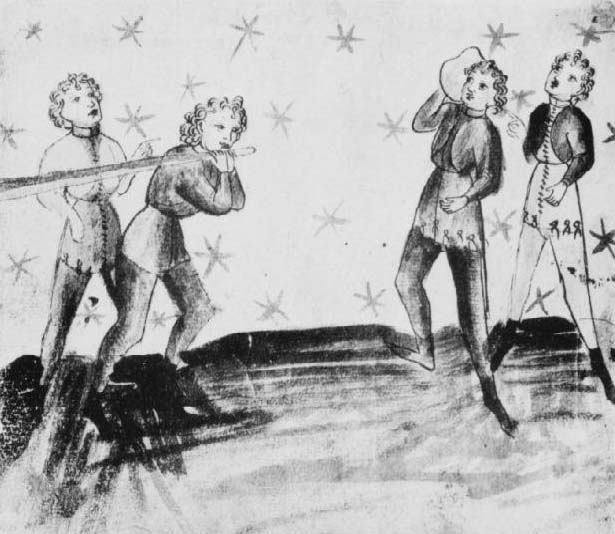 The 1443 edition of
Hans Talhoffer's Fechtbuch also includes a plate image (number
T16 in the 1889 Hergsell edition) of two men training at night
with large stones and heavy sticks. The figures may possibly be
commoners preparing for a judicial combat as the scene appears
in the middle of a section on just such ritual dueling using special
fighting-shields. A Medieval "housebook" of c. 1482 also displays exercises
among knights consisting of stone lifting, stick play, wrestling,
and staff fighting, with longswords lying on the ground nearby.
The accompanying verses, symbolizing Jupiter and the sun, read:
"All morning long to God they pray, and after noon they laugh
and play. They wrestle and they fence with swords, they throw
big stones, and serve great lords. Manly exercises are their sports,
they have good luck in princely courts."
The 1443 edition of
Hans Talhoffer's Fechtbuch also includes a plate image (number
T16 in the 1889 Hergsell edition) of two men training at night
with large stones and heavy sticks. The figures may possibly be
commoners preparing for a judicial combat as the scene appears
in the middle of a section on just such ritual dueling using special
fighting-shields. A Medieval "housebook" of c. 1482 also displays exercises
among knights consisting of stone lifting, stick play, wrestling,
and staff fighting, with longswords lying on the ground nearby.
The accompanying verses, symbolizing Jupiter and the sun, read:
"All morning long to God they pray, and after noon they laugh
and play. They wrestle and they fence with swords, they throw
big stones, and serve great lords. Manly exercises are their sports,
they have good luck in princely courts."
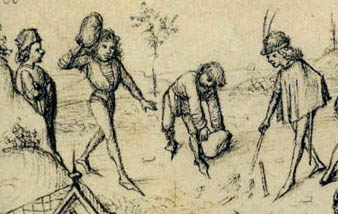 In German regions this stone tossing was later known
as, Schiessen der Stange. Another image from c.1531
of Fechters exercising outside shows them again wrestling,
fencing with two-hand swords and dussack, and preparing to toss
large stones. Castiglione in 1526 even advised "to cast
the stone" as being one of those exercises befitting a courtier
which, though not directly related to the practice of arms, held
"a greate agreemente with them." A late 15th century illuminated
image by Jardin de Vertueuse (J. P. H Getty museum, MS. Ludwig
XV 8, fol. 99) depicting the competition in Sittacene and the
placating of Sisigambis from the life of Alexander illustrates
the same familiar one-handed lifting of large round stones, and
hefting over the head of short wide sticks along with gymnastic
exercises.
In German regions this stone tossing was later known
as, Schiessen der Stange. Another image from c.1531
of Fechters exercising outside shows them again wrestling,
fencing with two-hand swords and dussack, and preparing to toss
large stones. Castiglione in 1526 even advised "to cast
the stone" as being one of those exercises befitting a courtier
which, though not directly related to the practice of arms, held
"a greate agreemente with them." A late 15th century illuminated
image by Jardin de Vertueuse (J. P. H Getty museum, MS. Ludwig
XV 8, fol. 99) depicting the competition in Sittacene and the
placating of Sisigambis from the life of Alexander illustrates
the same familiar one-handed lifting of large round stones, and
hefting over the head of short wide sticks along with gymnastic
exercises. 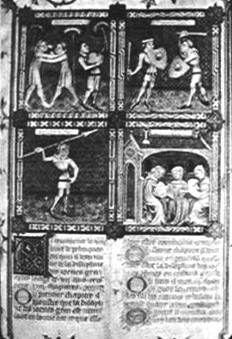 In his 1555, History of the Nordic Peoples, the exiled
Swedish archbishop Olaus Magnus wrote of warrior exercises noting
that: "Stones or blocks they throw so that they will learn how
to with force heave aside obstacles or hold heavy objects lifted,
as it is to become of those, who in combat have become wounded;
since these shall be brought out of the battle to quickly get
medical care, they must be supported upon the arms of strong comrades
so that they will not fall down." A woodcut illustrates a band
of youths lifting stones, working with sticks and engaged in gymnastics.
Leaping and jumping are listed as a way of staying fit and avoiding
obesity since a "too well fed and fattened belly will not make
them able to help themselves or others when it comes to mounting
or dismounting the horse to flee or to attack." (14th chapter,
p. 685. Translation by Joachim Nilsson, 2004). All of this stone
throwing harkens back to the classical Greek shot put designed
to strengthen the arms for throwing spears and delivering blows.
Explaining the role and importance
of exercise for military training, Magnus further described, "Since
a hateful deterioration results from idleness and inertia, especially
when it comes to soldiering, provision was made in ancient times,
lasting to this day, that in order to win wars young men should
be broken in with the curb of military discipline and develop
their powers by continued agility, some with spears, others by
hurling stones, others by jumping or running." He added that the
purpose of exercise with heavy spears or wooden shafts was to
be able to wield heavy pole-arms in penetrating effectively through
heavy armor. (Magnus, p. 739).
In his 1555, History of the Nordic Peoples, the exiled
Swedish archbishop Olaus Magnus wrote of warrior exercises noting
that: "Stones or blocks they throw so that they will learn how
to with force heave aside obstacles or hold heavy objects lifted,
as it is to become of those, who in combat have become wounded;
since these shall be brought out of the battle to quickly get
medical care, they must be supported upon the arms of strong comrades
so that they will not fall down." A woodcut illustrates a band
of youths lifting stones, working with sticks and engaged in gymnastics.
Leaping and jumping are listed as a way of staying fit and avoiding
obesity since a "too well fed and fattened belly will not make
them able to help themselves or others when it comes to mounting
or dismounting the horse to flee or to attack." (14th chapter,
p. 685. Translation by Joachim Nilsson, 2004). All of this stone
throwing harkens back to the classical Greek shot put designed
to strengthen the arms for throwing spears and delivering blows.
Explaining the role and importance
of exercise for military training, Magnus further described, "Since
a hateful deterioration results from idleness and inertia, especially
when it comes to soldiering, provision was made in ancient times,
lasting to this day, that in order to win wars young men should
be broken in with the curb of military discipline and develop
their powers by continued agility, some with spears, others by
hurling stones, others by jumping or running." He added that the
purpose of exercise with heavy spears or wooden shafts was to
be able to wield heavy pole-arms in penetrating effectively through
heavy armor. (Magnus, p. 739).
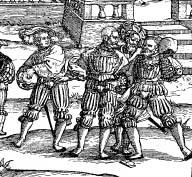 The noted 19th century
researcher into Medieval fencing, Dr. Karl Wassmannsdorff, stated
that knightly physical training in the German regions from at
least the 1400's included riding, fencing, horse-jumping, dancing,
wrestling, and running, but by the 1500s this became limited to
the first four before being done away with entirely. (Turnen und
Fechten, p. 1-4). To train the legs for running and jumping they
performed Wandlaufen, or wall running and jumping over various
obstacles. For upper-body strength they performed Steinstossen
(stone throwing) and Stangeschieben (essentially pole or lance
pushing). In Stangeschieben the thinner end of a stick was held
over the right shoulder with the larger end behind. The pole was
then raised vertical over the head and thrown as far as possible,
landing so that the thicker end faced away.
The noted 19th century
researcher into Medieval fencing, Dr. Karl Wassmannsdorff, stated
that knightly physical training in the German regions from at
least the 1400's included riding, fencing, horse-jumping, dancing,
wrestling, and running, but by the 1500s this became limited to
the first four before being done away with entirely. (Turnen und
Fechten, p. 1-4). To train the legs for running and jumping they
performed Wandlaufen, or wall running and jumping over various
obstacles. For upper-body strength they performed Steinstossen
(stone throwing) and Stangeschieben (essentially pole or lance
pushing). In Stangeschieben the thinner end of a stick was held
over the right shoulder with the larger end behind. The pole was
then raised vertical over the head and thrown as far as possible,
landing so that the thicker end faced away.
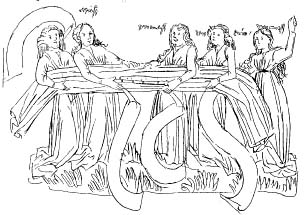 Another form of strength
training called Strebkatze consisted of various forms of "tug-of-war"
games using rope or cloth. According to Wassmannsdorff this training
was good for fencing with longswords or two-handed weapons because
it strengthened the muscles used in descending cuts. Finally, playful
forms of milder non-combat grappling or wrestling were also conducted.
(Turnen und Fechten, p. 11-18).
Another form of strength
training called Strebkatze consisted of various forms of "tug-of-war"
games using rope or cloth. According to Wassmannsdorff this training
was good for fencing with longswords or two-handed weapons because
it strengthened the muscles used in descending cuts. Finally, playful
forms of milder non-combat grappling or wrestling were also conducted.
(Turnen und Fechten, p. 11-18).
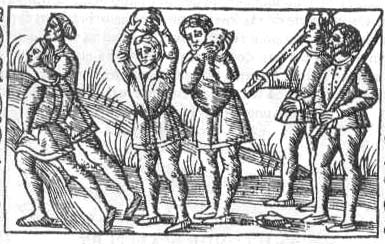 In
eras where physical harm from fellow humans was daily a real possibility,
knowledge of self-defence kept a man free and safe. But in time,
the study of arms became a discipline that could be pursued for
its own end, for its values of health, vigor, and well-being, yet
never conducted without regard to values defined by other liberal
studies. This humanistic ideal of fitness is very much an important
aspect of our Renaissance martial heritage.
In
eras where physical harm from fellow humans was daily a real possibility,
knowledge of self-defence kept a man free and safe. But in time,
the study of arms became a discipline that could be pursued for
its own end, for its values of health, vigor, and well-being, yet
never conducted without regard to values defined by other liberal
studies. This humanistic ideal of fitness is very much an important
aspect of our Renaissance martial heritage.
Fitness among the Masters
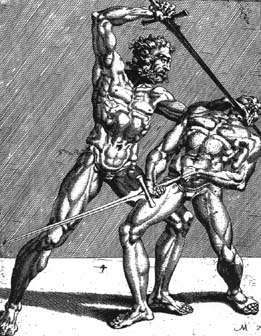 There is no question that, historically,
the very purpose of a fighting Art was to permit a skilled
person to overcome a physically more powerful one. Skill always
transcends mere strength alone or advantages of frame and size.
As Master Liechtenauer taught in the 14th century,
"it is always the art that should go before the strength." Simultaneously
however, as the ancient Greeks well knew and Renaissance fighting
men later understood, fitness of the body permits more adept performance
of such skills. The historical source manuals frequently portray
figures in fine physical form and in some cases, following classical
ideas, depict particularly athletic combatants. There is no question
Renaissance fighting men embraced physical health and fitness.
Though Liechtenauer taught, "a weak man would more certainly win
with his art and cunningness [more] than a strong man with his
strength" and the master Fillipo Vadi in the 1480s taught "cunning
defeats any strength", they surely did not mean that a skilled
fighter need not bother at all with developing physical strength.
There has long been the recognition in Western martial arts that
fighting involves considerable emotional or psychological elements.
For example, the Flemish rapier master Girard Thibault in 1623
wisely noted the importance of perception and skill in fighting
over pure physicality, saying that those who "try to succeed solely
by long and continual exercises in quickness of the body and of
the arm, by which they are able to prevail by forestalling and
taking advantage of opponents rather than by compelling them,
do not comprehend the secrets." As Cervantes related in his 1614,
Don Quixote, "force is overcome by Art."
There is no question that, historically,
the very purpose of a fighting Art was to permit a skilled
person to overcome a physically more powerful one. Skill always
transcends mere strength alone or advantages of frame and size.
As Master Liechtenauer taught in the 14th century,
"it is always the art that should go before the strength." Simultaneously
however, as the ancient Greeks well knew and Renaissance fighting
men later understood, fitness of the body permits more adept performance
of such skills. The historical source manuals frequently portray
figures in fine physical form and in some cases, following classical
ideas, depict particularly athletic combatants. There is no question
Renaissance fighting men embraced physical health and fitness.
Though Liechtenauer taught, "a weak man would more certainly win
with his art and cunningness [more] than a strong man with his
strength" and the master Fillipo Vadi in the 1480s taught "cunning
defeats any strength", they surely did not mean that a skilled
fighter need not bother at all with developing physical strength.
There has long been the recognition in Western martial arts that
fighting involves considerable emotional or psychological elements.
For example, the Flemish rapier master Girard Thibault in 1623
wisely noted the importance of perception and skill in fighting
over pure physicality, saying that those who "try to succeed solely
by long and continual exercises in quickness of the body and of
the arm, by which they are able to prevail by forestalling and
taking advantage of opponents rather than by compelling them,
do not comprehend the secrets." As Cervantes related in his 1614,
Don Quixote, "force is overcome by Art."
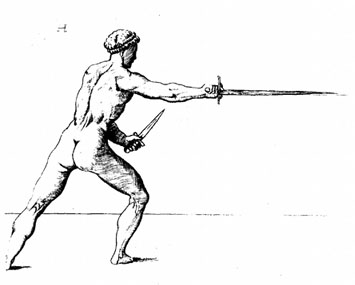 There is a simple but obvious dynamic at
work in all this: practice puts you in better shape; being in better
shape puts you in better practice. Jacopo Porcia, the military writer
and humanist educator, in his military treatise from the 1470s
(translated into English by Peter Betham in 1544 as, The Preceptes
of Warre), provided advice on keeping troops fit and prepared for
fighting by training in mock combat (section 33): "For accordyng to
their exercyse, so shall they be in strength and valiant-nesse. And
this is the onely meane to make our army strong and lustye. The
capitayne may somtyme for theyr exercyse, devyde his souldyours and
ordre them in forme and lykenesse of a battayle. But he must beware of
bloodsheddyng, lest some discorde and quarellyng, therof do ryse…"
Commenting on how "Yonge men ought to be chosen for soldyours" (section
185) Porcia also advised to select those which "have a pleasure to
handle weapons, to fyght, takyng it for a sporte and game. Suche
fellowes lustye and stronge, be lyke to become valiaunte and expert
warryours…" Writing "Of exercyse" (in section 99), Jacopo also advised:
"For what science is that whyche can be kepte flouryshyng without
exercyse, when exercyse doeth passe and overcome nature…” For "a
skylfulle capytayne ought to dryve hys men to some kynde of exercise
[i.e., exercitus], lest they be astonyshed, when tyme is that
they must fyght." Later he added (in section 183) how, "this science as
it is gotten and assured by exercise, so is it lost by negligence."
There is a simple but obvious dynamic at
work in all this: practice puts you in better shape; being in better
shape puts you in better practice. Jacopo Porcia, the military writer
and humanist educator, in his military treatise from the 1470s
(translated into English by Peter Betham in 1544 as, The Preceptes
of Warre), provided advice on keeping troops fit and prepared for
fighting by training in mock combat (section 33): "For accordyng to
their exercyse, so shall they be in strength and valiant-nesse. And
this is the onely meane to make our army strong and lustye. The
capitayne may somtyme for theyr exercyse, devyde his souldyours and
ordre them in forme and lykenesse of a battayle. But he must beware of
bloodsheddyng, lest some discorde and quarellyng, therof do ryse…"
Commenting on how "Yonge men ought to be chosen for soldyours" (section
185) Porcia also advised to select those which "have a pleasure to
handle weapons, to fyght, takyng it for a sporte and game. Suche
fellowes lustye and stronge, be lyke to become valiaunte and expert
warryours…" Writing "Of exercyse" (in section 99), Jacopo also advised:
"For what science is that whyche can be kepte flouryshyng without
exercyse, when exercyse doeth passe and overcome nature…” For "a
skylfulle capytayne ought to dryve hys men to some kynde of exercise
[i.e., exercitus], lest they be astonyshed, when tyme is that
they must fyght." Later he added (in section 183) how, "this science as
it is gotten and assured by exercise, so is it lost by negligence."
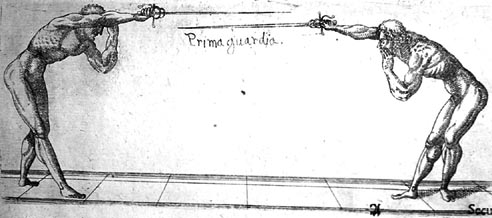 Leading
Renaissance martial arts researcher and senior ARMA advisor, Sydney
Anglo, has related that the civic benefits of training in arms were a
great concern of humanist educators in the Renaissance:
"Educationalists without fail, recommended some form of physical
training. What they never explained was how instruction in the handling
of weapons should be given and by whom." Yet, the obvious answer
is they surely meant it would be accomplished by Masters of
Defence. Physical fitness and athleticism was especially prized
in Renaissance culture and masters of arms certainly were not silent on
the subject. Liechtenauer himself included "a ready and healthy body"
as something which pertained to rightful fighting along with "exercises
and good health." Recommendations for fencing as an excellent form of
healthy exercise also abounded in 16th century works. Geoffroi De
Charny's 14th century book of chivalry in describing how "A good man at
arms should not pamper his body," even warned fighting men against poor
eating habits, observing that, "otherwise they will be in too great
distress because of the great delight they take in such things. And
because of this gluttony, they dread the hardship associated with deeds
of arms." To this he even added advice on Spartan sleeping habits "to
achieve physical fitness and honor." (Charny, p. 123).
Leading
Renaissance martial arts researcher and senior ARMA advisor, Sydney
Anglo, has related that the civic benefits of training in arms were a
great concern of humanist educators in the Renaissance:
"Educationalists without fail, recommended some form of physical
training. What they never explained was how instruction in the handling
of weapons should be given and by whom." Yet, the obvious answer
is they surely meant it would be accomplished by Masters of
Defence. Physical fitness and athleticism was especially prized
in Renaissance culture and masters of arms certainly were not silent on
the subject. Liechtenauer himself included "a ready and healthy body"
as something which pertained to rightful fighting along with "exercises
and good health." Recommendations for fencing as an excellent form of
healthy exercise also abounded in 16th century works. Geoffroi De
Charny's 14th century book of chivalry in describing how "A good man at
arms should not pamper his body," even warned fighting men against poor
eating habits, observing that, "otherwise they will be in too great
distress because of the great delight they take in such things. And
because of this gluttony, they dread the hardship associated with deeds
of arms." To this he even added advice on Spartan sleeping habits "to
achieve physical fitness and honor." (Charny, p. 123).
The Hispano-Italian master of arms and
knight, Pietro Monte, who wrote voluminously on fighting and military
arts at the end of the 15th century, included a concise
chapter on body conditioning and diet in his Colecteanea
work published in 1509. Monte advocated weight lifting,
running sprints, and other callisthenic workouts in order to achieve
the ideal martial physique—again, in the classic model.
As many Renaissance writers did, Monte stressed the importance
of physical conditioning and exercises as key to health, happiness,
and martial prowess. The Dutch artist Martin von Heemskerk
in 1552 produced a series of detailed fencing and wrestling woodcut
engravings consisting of muscular athletes engaged in short sword,
two-handed sword, and wrestling. The nude figures reflecting a
physical ideal in the classical style are reminiscent of those
appearing in Camillo Agrippa's early rapier fencing treatise published
two years later.
In 1570, the master Giacomo Di Grassi wrote on
the importance of fitness, saying, “let every man that is desirous to
practice this Art, endeavor himself to get strength and agility of
body, assuring himself, that judgment without this activity and force,
avails little or nothing.” Di Grassi further declared, "that strength
of body is very necessary to attain to the perfection of this Art, it
being one of the two principal beginnings first laid down."
He then added, "For men being blinded in their own judgments, and
presuming on this, because they know how, and what they ought to do,
give many times the onset and enterprise, but yet, never perform it in
act." In his section on exercise Di Grassi instructed, “how a man by
private practice may obtain strength of body” advising, “For tahe
obtaining of this strength and activitie, three things ought to be
considered, to witte, the armes, the feete and the leggs, in each of
which it is requisite that everie one be greatlie exercised…”
Yet, he also added later, “For the ende of this arte is not to lifte up
or beare great burdens, but to move swiftelie. And there is no doubt
but he vanquisheth which is most nimble, and this nimblenesse is not
obtained by handling of great heftes or waightes, but by often moving.”
Underscoring the need for practice and exercise, Di Grassi also stated
that “judgment without…activitie and force, availeth litle or
nothinge.”
Di Grassi even went to on to state how for the
swordsman, “it is principally necessary that (as in other weapons
...they both be active in body and strong in the arms, which are
required in the managing of each weapon.” Di Grassi was
quite explicit in the need for continual physical conditioning for
effective fencing, even commenting on how lack of it would lead to
discouragement in the student:
"Yet a man be never so strong and lustie, yet he shall
deliver a blowe more slowe and with less force than an other shall who
is lesse strong, but more exercised: & without doubt he shall so
werie his armes, handes and bodie, that he cannot long endure to labour
in any such busines. And there hath beene manie, who by reason of such
sudden wearines, have suddenlie dispaired of themselves, giving over
the exercise of the weapon, as not appertaining unto them. Wherein they
deceive themselves, for such wearines is vanquished by exercise, by
meanes whereof it is not long, but that the bodie feete & armes are
so strengthened, that heavie things seem light, & that they are
able to handle verie nimblie anie kinde of weapon, and in briefe
overcome all kind of difficulty and hardnesse. Therefore when one would
exrecise his armes, to the entent to gette strength, he must endevour
continuallie to overcome wearines, resolving himselfe in his judgement,
that paines is not caused, through debilitie of nature, but rather
hangs about him, because he hath not accustomed to exercise his members
thereunto."
Di Grassi
finally added that physical fitness was directly related to fighting
skill: "Farther, when he shall perceive, that he hath conveniently
qualified and strengthened this instrument of his bodie, it shall
remaine, that he onely have recourse in his minde to the fine
advertisements, by the which a man obtaineth judgement."
Similarly,
in Vincentio Saviolo's 1595, His Practice in Two Books, we
read from the "First Dayes Discourse" concerning the rapier and
dagger: "Therefore hee that wil exercise these rudiments must have
a very apt and well framed body…" As did others, English
master George Silver, in his famous 1599, Paradoxes of Defense,
rightly observed the health benefits of martial arts: "exercising
of weapons puts away aches, griefs, and diseases, it increases strength,
and sharpens the wits. It gives a perfect judgement, it expels
melancholy, choleric and evil conceits, it keeps a man in breath,
perfect health, and long life." In addition to striking at
a wall target with a heavy sword dozens of times a day and vaulting
on the traditional wooden pommel-horse for exercising the body in
agility, Francesco Alfieri in his 1640 fencing treatise included
a chapter on "The Gentleman's Exercises" (Gli esercizi del cavaliere),
wherein he advocated playing with a pike or a two-handed sword as
being highly beneficial to body conditioning.
In his elaborate tome on fencing with the rapier from 1630, the master
Girard Thibault d’Anvers commented that, “the lover of this art, who
will render himself capable of it, will borrow courage and assurance of
arms, even if he lacks the certitude and dexterity of their usage by the
feebleness of his forces.” Yet even this master known for a
method emphasizing finesse and grace, also observed, “It is certain that
the strength of the body is of very great importance when it comes to
striking…We hold our physical strength in great esteem, but we know that
we lose its fruit, if we try to use it before the right time.” (John
Michael Greer. Academy of the Sword, Chivalry Bookshelf, 2006, p. 71
& 149)
The Modern Place
No training, no matter how good, can prepare a man for
the reality of battle. The most that can be done is instill
basic responses, physical conditioning, and mental toughness.
But history shows that physical conditioning can make all the
difference. 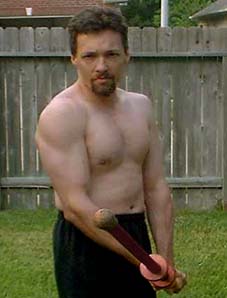 The core muscles that permit balance, coordination,
and agility are the keys for the development of superior
neuromuscular skills—critical for an activity like fencing
or wrestling. Interestingly, balance, coordination, and agility—elements
ideal for the functional capacity necessary for superior
fighting ability—are themselves largely independent of muscularity,
cardio-endurance, and even body-fat ratio. While weapons training
arguably works the arms and legs more than other areas of the
body, when performed correctly and with sufficient effort it also
holistically works the small muscle groups as well—the ones
that build stability and hold everything together. Thus,
many exercise experts today are more and more emphasizing core
conditioning, that is, not big muscularity and definition
or even aerobic endurance, but improved proprioceptive
awareness: neuromuscular conditioning for improved balance,
coordination, reflexes, and agility. These are the very factors
in higher martial arts skill. As our Renaissance forebears
knew, these elements of fitness are achieved through the practice
of arms combined with bodily exercises. There was nothing mystical
or preternatural about the spatial and temporal acuity achieved
from this.
The core muscles that permit balance, coordination,
and agility are the keys for the development of superior
neuromuscular skills—critical for an activity like fencing
or wrestling. Interestingly, balance, coordination, and agility—elements
ideal for the functional capacity necessary for superior
fighting ability—are themselves largely independent of muscularity,
cardio-endurance, and even body-fat ratio. While weapons training
arguably works the arms and legs more than other areas of the
body, when performed correctly and with sufficient effort it also
holistically works the small muscle groups as well—the ones
that build stability and hold everything together. Thus,
many exercise experts today are more and more emphasizing core
conditioning, that is, not big muscularity and definition
or even aerobic endurance, but improved proprioceptive
awareness: neuromuscular conditioning for improved balance,
coordination, reflexes, and agility. These are the very factors
in higher martial arts skill. As our Renaissance forebears
knew, these elements of fitness are achieved through the practice
of arms combined with bodily exercises. There was nothing mystical
or preternatural about the spatial and temporal acuity achieved
from this.
Besides the mental or psychological elements,
the physical attributes vital to the martial art of historical fencing
are arguably strength in the legs and arms and agility in the body.
Strong legs ensure firm and speedy footwork along with balance and
leverage. Strong arms permit the quick and powerful wielding of weapons
in offensive and defensive movements. A healthy physique naturally
allows for balanced and synchronized movement as well as strength,
dexterity, and endurance.
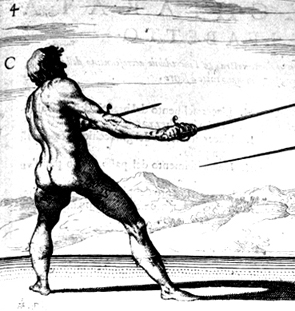 Historically,
organized combative systems were developed for, and evolved through,
battlefield situations (or their civilian equivalent) with their
functions ranging from actual fighting to entertainment and sport.
These martial arts were about personal self-defense.
All myths to the contrary aside, no warrior in history created
a combative system that was exclusively for purposes of exercise,
health, or entertainment. As we today are now pursuing them
only for reasons other than true self-defence we must acknowledge
our motives and goals are not those of the original historical
purpose and function that first spawned and necessitated these
skills in the first place. The period source materials that
we study were concerned with serious combat and that's how it
should be approached today—even if it is merely now theoretical
with debatable practical value. Just as with the actual
original students of the craft, we too must still practice safely
by conducting training exercises.
Historically,
organized combative systems were developed for, and evolved through,
battlefield situations (or their civilian equivalent) with their
functions ranging from actual fighting to entertainment and sport.
These martial arts were about personal self-defense.
All myths to the contrary aside, no warrior in history created
a combative system that was exclusively for purposes of exercise,
health, or entertainment. As we today are now pursuing them
only for reasons other than true self-defence we must acknowledge
our motives and goals are not those of the original historical
purpose and function that first spawned and necessitated these
skills in the first place. The period source materials that
we study were concerned with serious combat and that's how it
should be approached today—even if it is merely now theoretical
with debatable practical value. Just as with the actual
original students of the craft, we too must still practice safely
by conducting training exercises.
Unfortunately, there is still a detectable
undercurrent of negativity among many within the historical fencing
community toward the very idea of athleticism and fitness, as if
acknowledging its substance somehow spoils the fun (or at the least,
perhaps suggests the corollary that fitness and athletics are contrary
to its pursuit). This is a pity since the two activities should be
understood as symbiotic and complementary.
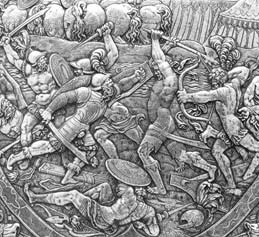 There's no question today that the vast
majority of historical fencing enthusiasts do not live a lifestyle like
that of our Renaissance ancestors. Perhaps compared to us now
they were less comfortable overall, or due to inferior medical science
less healthy in the long run, but mostly they lived more active
lives. Unlike us, they did not sit down for 10 to 12 hours a day
as we typically do and even simple tasks we now take for granted might
involve considerable physical labor. Everyday they walked most
everywhere, rode horses frequently, ate few sweets and plenty of fresh
(not canned or processed) vegetables and grains. It is understandable
then that a practitioner who might feel over weight, out of shape, or
because of lifestyle habits just knows they are not in the best
physical condition they could or should be, may find descriptions of
the importance of fitness in this subject intimidating or depressing.
That's unfortunate, for the purpose of this article is to explore the
historical role of fitness in Renaissance martial arts and place it in
proper context for today's enthusiast.
There's no question today that the vast
majority of historical fencing enthusiasts do not live a lifestyle like
that of our Renaissance ancestors. Perhaps compared to us now
they were less comfortable overall, or due to inferior medical science
less healthy in the long run, but mostly they lived more active
lives. Unlike us, they did not sit down for 10 to 12 hours a day
as we typically do and even simple tasks we now take for granted might
involve considerable physical labor. Everyday they walked most
everywhere, rode horses frequently, ate few sweets and plenty of fresh
(not canned or processed) vegetables and grains. It is understandable
then that a practitioner who might feel over weight, out of shape, or
because of lifestyle habits just knows they are not in the best
physical condition they could or should be, may find descriptions of
the importance of fitness in this subject intimidating or depressing.
That's unfortunate, for the purpose of this article is to explore the
historical role of fitness in Renaissance martial arts and place it in
proper context for today's enthusiast.
The question then
for today's student and scholar of Renaissance martial discipline
is, how much will you allow this to influence and inspire your
own activities? The role of fitness should not be something that
we ignore or that discourages us, but that we place with everything
else we learn and include in our study—i.e., sense of timing
and range, proficiency in techniques, awareness, mental clarity
and focus, etc. This is an important aspect of raising the
credibility and legitimacy of Renaissance martial arts as well
as improving your own performance. Whether we acknowledge it as
true or not, the act of practicing and fighting with swords and
weapons, as well as grappling and wrestling, are vigorous physical
activities the performance of which (regardless of other intangibles)
is enhanced by athleticism and fitness.
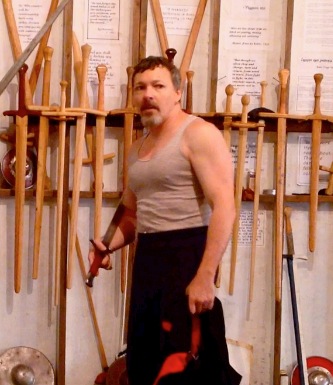 Every
serious practitioner of Renaissance martial arts today should
endeavor to have their own regimen of physical exercise (along
with a sensible diet) to complement their study and training.
Whether it consists of some weight lifting, aerobic exercise,
running, stretching, pilates, yoga, etc., is up to each student.
As the late-16th century Dutch protestant theologian, Francis
Johnson, stated, "I take the true definition of exercise to be,
labor without weariness." There are plenty of resources online
that can assist readers with advice and information for devising
a program (after consulting with a qualified physician). The bottom
line is to do something as an adjunct to your fencing.
Not being in good shape is no excuse for not beginning activities
that will help you get in better shape. In the end, practicing
a martial art is the best way to get in shape for a martial
art. Whether your weapon of choice is the largest two-handed
sword or the thinnest rapier, the exercise of the body goes hand
in hand with the Exercise of Armes.
Every
serious practitioner of Renaissance martial arts today should
endeavor to have their own regimen of physical exercise (along
with a sensible diet) to complement their study and training.
Whether it consists of some weight lifting, aerobic exercise,
running, stretching, pilates, yoga, etc., is up to each student.
As the late-16th century Dutch protestant theologian, Francis
Johnson, stated, "I take the true definition of exercise to be,
labor without weariness." There are plenty of resources online
that can assist readers with advice and information for devising
a program (after consulting with a qualified physician). The bottom
line is to do something as an adjunct to your fencing.
Not being in good shape is no excuse for not beginning activities
that will help you get in better shape. In the end, practicing
a martial art is the best way to get in shape for a martial
art. Whether your weapon of choice is the largest two-handed
sword or the thinnest rapier, the exercise of the body goes hand
in hand with the Exercise of Armes.
*Note:
bibliographic references have been removed from this online version
prior to print publication.
© Copyright 2005 by John Clements
& the ARMA. Updated 8-2014.
A useful source for gear associated
with self-training for fitness is:
http://www.manvsweight.com/calisthenics-equipment/


 In Havelok the Dane, written
between 1280 and 1290, we read of this in a description of knights
enjoying exercise: "The moste joye that mouhte be—Wrastling
with laddes, putting of ston" (i.e, threw heavy stones). In
a short English play from c.1470, "Robyn Hod and the Shryff off
Notyngham," several activities are described similar to those traditionally
performed in May games, including stone throwing, wrestling, and
vigorous sword fighting. Illustrations of German fencers from
the 15th century depict them engaged in a range of activities
from wrestling and lifting weights (throwing large stones) to performing
calisthenics and gymnastics.
In Havelok the Dane, written
between 1280 and 1290, we read of this in a description of knights
enjoying exercise: "The moste joye that mouhte be—Wrastling
with laddes, putting of ston" (i.e, threw heavy stones). In
a short English play from c.1470, "Robyn Hod and the Shryff off
Notyngham," several activities are described similar to those traditionally
performed in May games, including stone throwing, wrestling, and
vigorous sword fighting. Illustrations of German fencers from
the 15th century depict them engaged in a range of activities
from wrestling and lifting weights (throwing large stones) to performing
calisthenics and gymnastics.
 Another form of strength
training called Strebkatze consisted of various forms of "tug-of-war"
games using rope or cloth. According to Wassmannsdorff this training
was good for fencing with longswords or two-handed weapons because
it strengthened the muscles used in descending cuts. Finally, playful
forms of milder non-combat grappling or wrestling were also conducted.
(Turnen und Fechten, p. 11-18).
Another form of strength
training called Strebkatze consisted of various forms of "tug-of-war"
games using rope or cloth. According to Wassmannsdorff this training
was good for fencing with longswords or two-handed weapons because
it strengthened the muscles used in descending cuts. Finally, playful
forms of milder non-combat grappling or wrestling were also conducted.
(Turnen und Fechten, p. 11-18).